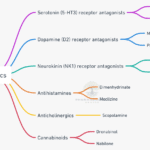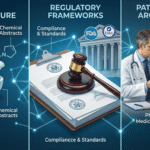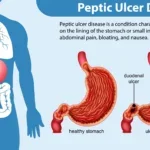Introduction
Peptic ulcer disease, gastritis, gastroesophageal reflux disease (GERD), and other erosive conditions of the gastrointestinal (GI) tract rank among the most common and debilitating ailments worldwide. In managing these disorders, mucosal protective agents have emerged as a pivotal therapeutic class, working not by neutralizing gastric acid or suppressing its secretion, but by shielding the gastric and duodenal mucosa from acid, pepsin, and other irritants. Collectively, these drugs—exemplified by sucralfate, bismuth compounds, and misoprostol—fortify the body’s innate mucosal defenses and promote healing of peptic ulcers (Goodman & Gilman, 2018).
This comprehensive review explores the pharmacology of mucosal protective agents, detailing their mechanisms of action, pharmacokinetic profiles, clinical indications, safety considerations, and evolving roles in GI practice. By examining the latest evidence—citing trusted references such as “Goodman & Gilman’s The Pharmacological Basis of Therapeutics,” “Katzung BG, Basic & Clinical Pharmacology,” and “Rang & Dale’s Pharmacology”—clinicians, pharmacists, and students can fully appreciate the significance of these agents in both conventional therapy and future advancements in GI care.
Overview of Gastric Mucosal Protection
Normal Mucosal Defense
The gastric mucosa preserves tissue integrity via several complementary mechanisms:
- Mucus-Bicarbonate Barrier: A continuous mucus layer traps bicarbonate ions, creating a neutral pH microenvironment adjacent to epithelial cells.
- Epithelial Cell Turnover: Rapid restitution and proliferation of surface cells replace those damaged by acid/pepsin exposure.
- Mucosal Blood Flow: Rich vascularization ensures prompt nutrient delivery and waste removal, aiding repair.
- Prostaglandins (PGs): Locally produced PGE2 and PGI2 stimulate mucus/bicarbonate secretion and maintain adequate mucosal blood flow (Katzung, 2020).
When these defense mechanisms are compromised—by Helicobacter pylori, NSAIDs, bile acids, or excessive acid/pepsin—ulcerations may occur. Mucosal protective agents bolster these host defenses, enhancing either physical protection, repair processes, or prostaglandin-related pathways (Rang & Dale, 2019).
Classification of Mucosal Protective Agents
While classification can vary, three prime categories illustrate current clinical practice:
- Sucralfate: A complex of sucrose sulfate and aluminum hydroxide forming a protective barrier.
- Colloidal Bismuth Compounds: e.g., Bismuth subsalicylate and Bismuth subcitrate.
- Prostaglandin Analogs: e.g., Misoprostol, synthetic analog of PGE1 (Goodman & Gilman, 2018).
Additional interventions like rebamipide (enhancing prostaglandin generation and mucosal defense) or ecabet sodium (promoting mucus secretion) also exist in certain markets, though their widespread usage remains more regional (Katzung, 2020).
Sucralfate
Chemistry and Mechanism of Action
Sucralfate comprises sucrose octasulfate complexed with aluminum hydroxide. Under acidic conditions (pH <4), sucralfate undergoes extensive cross-linking to form a viscous, sticky polymer that binds selectively to damaged mucosal sites. This polymer adheres strongly to ulcers, creating a physical barrier that prevents acid, pepsin, and bile salt penetration (Goodman & Gilman, 2018).Key mechanistic highlights:
- Localized Barrier: The protective coat can persist for up to 6 hours over the ulcer crater.
- Stimulation of Prostanoid Release: Sucralfate also encourages local prostaglandin E2 and bicarbonate secretion, augmenting mucosal resilience.
- No Direct Acid Suppression: Unlike proton pump inhibitors (PPIs) or H2 blockers, sucralfate does not reduce acid output. Its efficacy depends on mechanical coverage and enhancing local defenses (Rang & Dale, 2019).
Pharmacokinetics
- Minimal Systemic Absorption: Most sucralfate remains in the GI lumen. Only trace amounts of aluminum or sucrose sulfate are absorbed.
- Short Half-Life: The polymer forms at the ulcer site is stable under acidic conditions, but the direct protective effect is short-lived, necessitating multiple daily doses.
- Activation by Acid: Co-administration with antacids or PPIs can reduce sucralfate’s protective polymer formation (Katzung, 2020).
Clinical Uses
- Peptic Ulcer Disease (PUD): Primarily used for duodenal ulcers, sucralfate speeds healing and lowers recurrence rates when used consistently.
- Stress Ulcer Prophylaxis: In ICU settings, sucralfate can reduce GI bleeding risk, though PPIs are often favored for broad stress ulcer prophylaxis.
- Radiation Esophagitis/Gastritis: Sucralfate suspensions can soothe mucosal surfaces irritated by radiation therapy (Goodman & Gilman, 2018).
Dosing and Administration
- Typical regimen: 1 g orally 4 times daily (before meals and at bedtime), or 2 g twice daily.
- Must be taken on an empty stomach (1 hour before meals). Co-administration with acid-suppressing agents may diminish polymer formation, possibly compromising efficacy (Rang & Dale, 2019).
Adverse Effects and Interactions
- Constipation: Aluminum content can slow GI motility.
- Hypophosphatemia: Chronic aluminum ingestion can bind dietary phosphate.
- Bezoar Formation: Rare lumps in the GI tract, particularly in patients with gastroparesis.
- Drug Binding: Sucralfate can chelate or adsorb other medications (e.g., fluoroquinolones, tetracyclines, digoxin), necessitating dosing intervals (Katzung, 2020).
Bismuth Compounds
Types of Bismuth Salts
Two principal formulations see widespread usage:
- Bismuth subsalicylate (BSS): Commonly known as Pepto-Bismol, available over the counter.
- Bismuth subcitrate potassium: Often included in quadruple therapy regimens for H. pylori eradication (Goodman & Gilman, 2018).
Mechanism of Action
- Protective Coating: In acidic gastric environments, bismuth salts precipitate, forming insoluble complexes that embed in the ulcer base. This barrier resists acid and pepsin disruption.
- Antibacterial Activity: Bismuth exhibits a mild bactericidal effect against H. pylori and possibly fosters an environment less hospitable to bacterial colonization.
- Stimulating Prostaglandin and Mucus: Some data suggest bismuth compounds may enhance local prostaglandin synthesis, mucus output, and bicarbonate secretion (Rang & Dale, 2019).
Pharmacokinetics
- Low Systemic Absorption: Most ingested bismuth remains within the GI lumen, with minimal absorption.
- Salicylate Absorption: Bismuth subsalicylate releases salicylate, which can be systemically absorbed and influence platelet function or produce anti-inflammatory effects, albeit at modest levels (Katzung, 2020).
Clinical Uses
- H. pylori Eradication: Bismuth subcitrate is a core component in quadruple therapy (bismuth, metronidazole, tetracycline, PPI) for refractory H. pylori infection.
- Traveler’s Diarrhea: BSS can reduce stool frequency, quell gastric distress, and exhibit mild antimicrobial activity.
- Non-ulcer Dyspepsia: Bismuth preparations sometimes alleviate dyspeptic symptoms through mucosal coating (Goodman & Gilman, 2018).
Dosing and Administration
- Bismuth Subsalicylate: Varied OTC guidelines; often 524 mg (two tablespoons) every 30–60 minutes as needed, not exceeding recommended daily limits.
- Bismuth Quadruple Regimen: Usually includes 120–300 mg of subcitrate QID plus tetracycline, metronidazole, and a PPI for 10–14 days (Katzung, 2020).
Adverse Effects
- Black Stools: Reaction of bismuth with sulfur in saliva/GI tract yields black coloration. This is benign but can cause alarm if unanticipated.
- Darkening of Tongue: Temporary, harmless discoloration.
- Salicylate Toxicity: Large doses or prolonged usage might risk salicylate accumulation, especially in renal insufficiency (Rang & Dale, 2019).
Prostaglandin Analogs (Misoprostol)
Mechanism of Action
Misoprostol (a synthetic PGE1 analog) exerts mucosal protective actions similar to endogenous prostaglandins:
- Enhances Mucus & Bicarbonate Secretion: Reinforces the mucus-bicarbonate barrier.
- Promotes Mucosal Blood Flow: By vasodilation, fosters nutrient delivery and robust tissue remodeling.
- Acid Suppression: To a lesser extent, misoprostol may reduce parietal cell acid output, but the major advantage remains protective.
Thus, misoprostol effectively offsets the damaging impact of prostaglandin inhibition by NSAIDs, diminishing GI mucosal injury (Goodman & Gilman, 2018).
Pharmacokinetics
- Absorption: Orally bioavailable. Rapidly converted to active misoprostol acid.
- T1/2: Fairly short (~30 minutes), necessitating multiple daily dosing (QID) for consistent coverage.
- Renal Excretion: Eliminated via the kidneys; dose adjustment may be needed in renal impairment (Katzung, 2020).
Clinical Uses
- NSAID-Induced Ulcer Prophylaxis: Especially beneficial in high-risk patients (older adults, those with prior ulcer history) who require chronic NSAID therapy.
- Healing Preexisting Ulcers: Misoprostol can help heal existing NSAID-induced ulcers by re-establishing prostaglandin balance in the GI tract.
- Alternate Indications: Off-label usage in obstetrics for cervical ripening, postpartum hemorrhage, or medical abortion, reflecting the agent’s strong prostaglandin pharmacodynamic properties (Rang & Dale, 2019).
Dosing and Administration
- Typical regimen for ulcer prophylaxis: 200 mcg administered four times daily with meals and at bedtime. Lower doses (e.g., 100 mcg QID) can mitigate side effects but may compromise efficacy. Adherence to multiple doses daily can be challenging for some patients (Katzung, 2020).
Adverse Effects
- Diarrhea: A frequent side effect, possibly due to enhanced secretions and intestinal motility.
- Abdominal Cramps: Can be significant enough to limit compliance.
- Uterine Stimulation: Contraindicated in pregnancy due to abortifacient effects; pregnancy test required before therapy in women of childbearing potential (Goodman & Gilman, 2018).
Therapeutic Applications and Clinical Guidance
Peptic Ulcer Disease
Mucosal protective agents can facilitate duodenal and gastric ulcer healing, though they are often adjuncts to antisecretory therapies (PPIs/H2 antagonists) or used in specific contexts such as NSAID ulcers (misoprostol) or simpler regimens for mild duodenal ulcers (sucralfate). Bismuth-based quadruple therapy underscores the synergy of combining antibacterial and protective mechanisms in H. pylori management (Katzung, 2020).
Stress-Related Mucosal Damage
Stress ulcers typically arise in critically ill patients (ICU settings). Sucralfate and H2 receptor antagonists are two prophylactic choices. Although PPIs are more common, sucralfate remains an option when limiting nosocomial pneumonia risk is a priority, as it better preserves gastric pH and might reduce bacterial overgrowth (Rang & Dale, 2019).
Chronic NSAID Users
Misoprostol is particularly indicated for GI protection in patients who cannot discontinue NSAIDs. Alternatively, a selective COX-2 inhibitor or concurrent PPI is often employed. However, misoprostol’s side effects frequently hamper long-term compliance. Sucralfate is less effective in preventing NSAID-related ulcers but can be beneficial in mild cases (Goodman & Gilman, 2018).
Combination Regimens
- Bismuth plus metronidazole, tetracycline, and a PPI: This quadruple therapy, especially relevant for H. pylori resistant to clarithromycin, yields high eradication rates.
- Mucosal protective agent with acid suppression: Sucralfate or bismuth may be added to PPI therapy in severe cases or complicated refractory ulcers, though robust evidence for synergy is modest (Katzung, 2020).
Adverse Effects and Safety Considerations
General Tolerability
Overall, mucosal protective agents are well-tolerated due to limited systemic absorption. Nevertheless, caution arises in:
- Renal Dysfunction: Aluminum accumulation from sucralfate or bismuth toxicity.
- Pregnancy: Misoprostol can cause fetal harm; sucralfate or bismuth typically appear safer, though safety data remain incomplete.
- Children: BSS may be used short-term for diarrhea, but salicylate toxicity is a concern at high doses (Rang & Dale, 2019).
Allergic Reactions
Rare yet possible with any agent. Pruritus, rash, or anaphylaxis warrant discontinuation. Bismuth might aggravate salicylate allergy or aspirin-intolerant individuals (Katzung, 2020).
Drug Interactions
- Sucralfate: Has potential to bind or chelate multiple drugs (including some antibiotics, digoxin, warfarin). Time separation of ~2 hours is recommended.
- Bismuth: Additional salicylates or antiplatelets may increase bleeding risk.
- Misoprostol: Combining with magnesium-containing antacids can enhance diarrhea. Co-administering with oxytocic agents amplifies uterine contractions (Goodman & Gilman, 2018).
Comparative Effectiveness
Sucralfate vs. Bismuth
Both sucralfate and bismuth form protective coatings, hamper pepsin action, and have minimal systemic absorption. Bismuth, however, aids in H. pylori eradication, a unique advantage that sucralfate lacks. Conversely, sucralfate is less messy in terms of stool or tongue discoloration (Katzung, 2020).
Misoprostol vs. Other Approaches
Misoprostol is unmatched in offsetting prostaglandin depletion from NSAIDs and can significantly cut the incidence of NSAID-related ulcers. Yet its GI side effects (diarrhea, cramps), multi-daily dosing, and uterine stimulation hamper wide acceptance. PPIs are often chosen for GI prophylaxis, though misoprostol remains an option in selected high-risk patients (Rang & Dale, 2019).
Role in Modern Practice
PPIs and H2 blockers overshadow many mucosal protective agents in routine peptic ulcer disease management. However, sucralfate or bismuth may still be clinically relevant for specific tasks:
- Bismuth-based quadruple therapy: Combat resistant H. pylori strains.
- Sucralfate: Alternative for mild duodenal ulcers, or stress ulcer prophylaxis in specialized ICU settings.
- Misoprostol: Targeted prophylaxis in chronic NSAID therapy when other measures fail (Goodman & Gilman, 2018).
Special Populations
Renal Impairment
- Sucralfate: Chronic use might accumulate aluminum, particularly in end-stage renal disease, risking encephalopathy or osteomalacia. Monitoring is crucial.
- Bismuth: Usually minimal absorption, but caution in severe renal disease is recommended to avoid toxicity.
- Misoprostol: Primarily renally excreted, though generally safe with minor dose adjustments (Katzung, 2020).
Hepatic Dysfunction
Mucosal protective agents typically involve minimal hepatic metabolism, meaning no major dose changes for mild to moderate liver impairment. Nonetheless, close observation remains prudent (Rang & Dale, 2019).
Pediatric and Geriatric Populations
- Bismuth Subsalicylate: Watch for salicylate toxicity, Reye’s syndrome in children post-viral infection.
- Sucralfate: Safe in the elderly; main caution is constipation.
- Misoprostol: Not recommended for pregnant women. In older adults, GI distress may be limiting (Goodman & Gilman, 2018).
Future Perspectives and Research
Novel Protective Agents
Several experimental compounds aim to modulate mucosal growth factors or harness novel protective peptides, potentially surpassing existing barrier-forming approaches. Hybrid molecules that combine acid suppression with mucosal protection are also under study (Katzung, 2020).
Helicobacter pylori Eradication
Persistent or resistant H. pylori strains prompt new solutions, including advanced bismuth formulations or synergy with probiotics. The evolution of tailored bismuth-based regimens may prove pivotal as clarithromycin resistance escalates (Rang & Dale, 2019).
Personalized Strategies
Better comprehension of a patient’s microbiome, mucosal immunology, and genetic predispositions might refine selection among mucosal protectants, acid suppressors, or antibiotic regimens. Pharmacogenomic insights are still in early stages (Goodman & Gilman, 2018).
Minimizing Adverse Events
Formulations that mitigate misoprostol’s diarrheagenic pathways or reduce sucralfate’s aluminum burden could broaden these drugs’ acceptance. Ongoing research aims to preserve gastroprotective effects while diminishing side effects (Katzung, 2020).
Clinical Pearls and Best Practices
- Timing Matters: Sucralfate works best on empty stomach, forming stable complexes in acidic pH. Advise patients to ingest the medication 1 hour before meals and bedtime.
- Avoid Concomitant Agents: Alkali or potent acid suppression can impede sucralfate activation. Similarly, ensure spacing with other oral medications that sucralfate might bind.
- Assess H. pylori: If peptic ulcers persist, test for H. pylori. Bismuth-based quadruple therapy or other validated regimens can deliver comprehensive eradication.
- Exploit NSAID Offset: In high-risk NSAID users, consider misoprostol or an alternative COX-2 selective inhibitor plus PPI. If misoprostol is used, counsel on potential GI and obstetric side effects.
- Monitor for Tolerance: Though mucosal protective agents are mostly localized in effect, aluminum or salicylate accumulation can still occur in compromised renal function or after prolonged use. Check labs if suspicion arises (Rang & Dale, 2019).
Frequently Asked Questions
- Can Sucralfate Heal Ulcers Without Reducing Acid?
- Yes. Sucralfate fosters direct barrier protection and promotes local GI defenses. However, in severe acid hypersecretion states (Zollinger-Ellison syndrome), acid-suppressive therapy remains fundamental (Katzung, 2020).
- Is Bismuth Safe During Pregnancy?
- Data remain limited. Short courses at standard doses pose low systemic absorption; still, prudence suggests caution or alternative therapies. Consulting obstetric guidelines is recommended (Rang & Dale, 2019).
- Why is Misoprostol Not Popular if it Works Well?
- The high incidence of diarrhea, cramping, multiple-daily dosing, plus absolute pregnancy contraindication hamper acceptance. PPIs or H2 blockers are often more tolerable (Goodman & Gilman, 2018).
- Does Bismuth Subsalicylate Interfere with Aspirin or Antiplatelet Therapies?
- Potential cumulative salicylate effect could raise bleeding risk. Monitoring or dosing intervals can address minor concerns. Serious interactions are uncommon at standard OTC usage (Katzung, 2020).
- Do Mucosal Protective Agents Improve GERD?
- They can provide symptomatic relief, but acid-suppressive agents (PPIs/H2 antagonists) more effectively address esophageal acid reflux. Some sucralfate suspensions benefit mild erosive esophagitis (Rang & Dale, 2019).
Summary and Conclusions
Mucosal protective agents—spanning sucralfate, bismuth formulations, and misoprostol—offer distinct yet complementary approaches to managing peptic ulcers, gastritis, stress ulcer prophylaxis, and specific infection-related scenarios. By reinforcing the gastric lining, stimulating prostaglandin release, or supplying antibacterial actions (in bismuth’s case), these agents address the root vulnerabilities that enable acid and pepsin to erode the GI tract (Goodman & Gilman, 2018).
Although overshadowed by proton pump inhibitors and H2 blockers in many first-line treatment paradigms, mucosal protectants remain crucial in specialized contexts, including refractoriness to standard regimens, NSAID-induced ulcers (misoprostol), or as part of quadruple therapy for H. pylori. Evaluating patient-specific factors—such as renal function (for aluminum or salicylate concerns), pregnancy status (misoprostol contraindications), or the need for synergy in H. pylori eradication—guides optimal drug choice (Katzung, 2020).
Continuing research suggests potential expansions in these therapies’ roles via new formulations, combination strategies, and advanced mechanistic insights into GI mucosal immunity. For now, understanding each agent’s mechanism, appropriate use, and side effect profile ensures that clinicians can deploy mucosal protective agents effectively, enhancing both prophylactic and therapeutic outcomes in those experiencing erosive GI disorders (Rang & Dale, 2019).
References (Book Citations)
Rang HP, Dale MM, Rang & Dale’s Pharmacology, 8th Edition.
Goodman & Gilman’s The Pharmacological Basis of Therapeutics, 13th Edition.
Katzung BG, Basic & Clinical Pharmacology, 14th Edition.
📚 AI Pharma Quiz Generator
🎉 Quiz Results
Medical Disclaimer
The medical information on this post is for general educational purposes only and is provided by Pharmacology Mentor. While we strive to keep content current and accurate, Pharmacology Mentor makes no representations or warranties, express or implied, regarding the completeness, accuracy, reliability, suitability, or availability of the post, the website, or any information, products, services, or related graphics for any purpose. This content is not a substitute for professional medical advice, diagnosis, or treatment; always seek the advice of your physician or other qualified health provider with any questions you may have regarding a medical condition and never disregard or delay seeking professional advice because of something you have read here. Reliance on any information provided is solely at your own risk.









